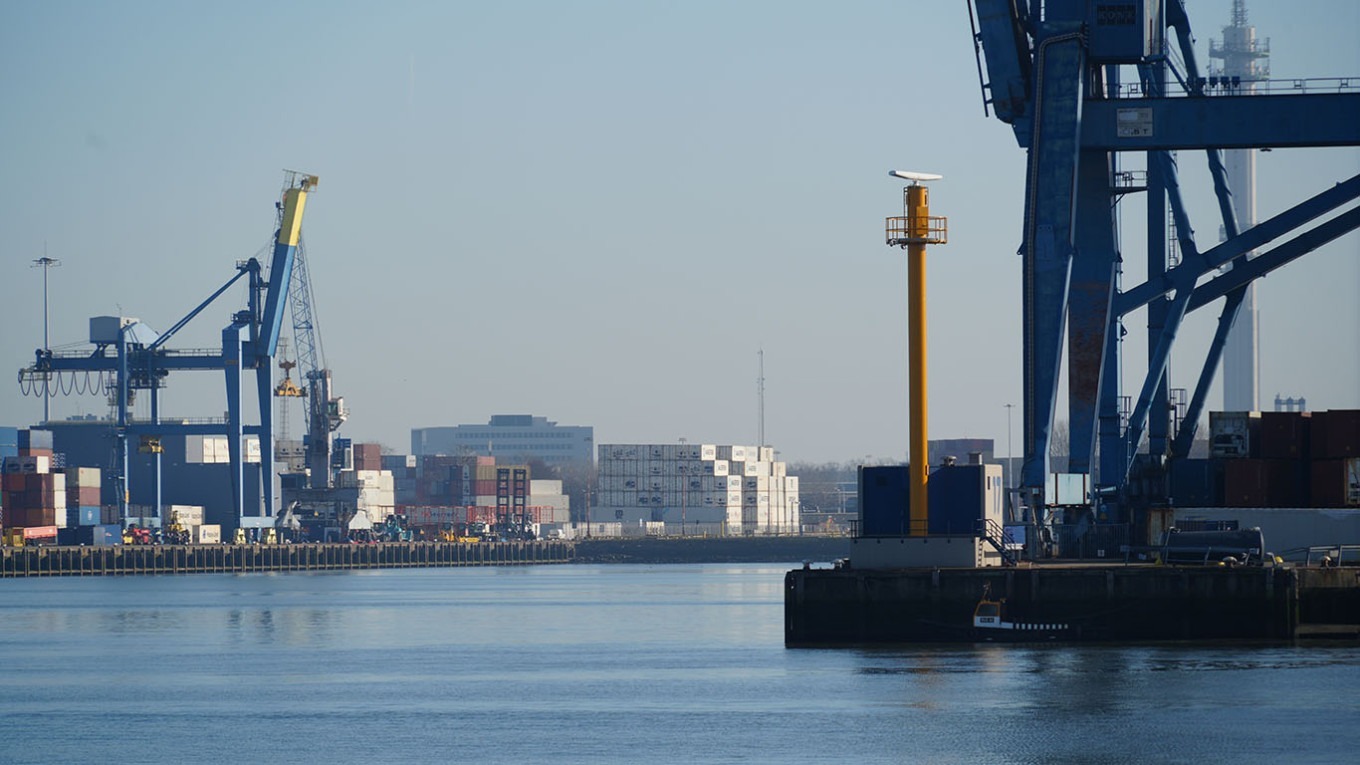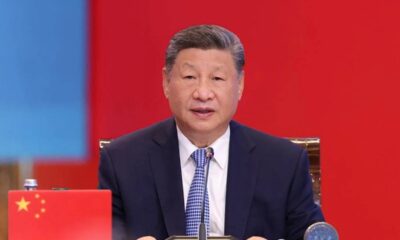Europe
Eurozone purchasing managers’ index hits 10-month low

Eurozone business activity fell sharply in November, raising the likelihood of a half-percentage-point interest rate cut by the European Central Bank (ECB) in December.
The Eurozone Composite Purchasing Managers’ Index (PMI), a widely watched economic indicator, unexpectedly dropped to 48.1 points, a 10-month low, according to estimates released on Friday by Hamburger Handelsbank. This reading is below the critical 50-point threshold that separates growth from contraction. Analysts had anticipated no change from last month’s neutral reading of 50.
“In the medium term, the outlook is gloomy, particularly due to the potential impact of [US President-elect Donald] Trump’s tariff policy on European growth,” said Christophe Boucher, chief investment officer at ABN AMRO Investment Solutions, in a note to clients quoted by the Financial Times (FT).
Rate cut already priced in
Investors reacted swiftly, with markets increasingly pricing in the possibility of a larger rate cut at the ECB’s 12 December meeting. The probability of a half-point cut nearly doubled to 55%, as implied by swap markets.
The weaker-than-expected business activity data also impacted the euro, which fell more than 1% to $1.033, marking its lowest level against the dollar since the energy supply crisis of late 2022.
Both the manufacturing sector and the services sector contracted in November, with the latter posting its lowest activity levels in 10 months.
“The eurozone manufacturing sector is sinking deeper into recession, and now the services sector is starting to struggle after two months of marginal growth,” said Cyrus de la Rubia, chief economist at HCOB, which publishes the index with S&P Global.
Recession likely to extend into early 2025
The PMI survey, regarded as one of the most reliable leading indicators of economic activity in the euro area, is closely monitored by monetary policymakers. Recent months have seen growing concerns within the ECB about sluggish growth and a faster-than-expected decline in inflation.
In the third quarter of 2024, the euro area’s economy grew by just 0.4% quarter-on-quarter. The ECB responded in October with its second consecutive quarter-point rate cut, bringing interest rates down to 3.25%.
So far, markets have broadly expected policymakers to implement additional quarter-point rate cuts over the next four meetings. However, November’s poor data has heightened fears of a recession, particularly for the last quarter of 2024 and the first quarter of 2025.
Commerzbank economist Ralph Solveen described the latest PMI figures as a “palpable setback” for hopes of a near-term recovery, adding that a recession now seems inevitable.
German exports continue to decline
Germany, the eurozone’s largest economy, has faced even worse-than-expected economic challenges. On Friday, Destatis, the German federal statistical office, halved its forecast for real GDP growth in the third quarter to 0.1%, following a 0.3% contraction in the second quarter.
Weak foreign trade played a significant role, with exports declining by 1.9% quarter-on-quarter, while imports rose marginally by 0.2%. The trend persisted in October, with exports to non-EU countries plummeting by 6.9%, according to a separate statement from Destatis.
“Germany has entered a protracted recessionary phase in a roundabout way,” said Andreas Scheuerle, an economist at Deka Bank in Frankfurt. He noted that a combination of cyclical and structural problems is weighing heavily on the EU’s largest economy, describing the situation as “poisonous.”
Europe
EU considers new €100 billion support fund for Ukraine

The European Union (EU) is reportedly considering the creation of a special €100 billion ($117 billion) support fund for Ukraine due to the ongoing war, which “shows no signs of ending.”
According to a report by Bloomberg, citing sources familiar with the matter, the fund is intended to be part of the EU’s next seven-year budget. If approved by member states, payments would begin in 2028 and continue until 2034. Discussions on the budget and related proposals are expected at the end of July, with the draft of the seven-year financial plan scheduled for release on July 16.
Existing aid totals €160 billion
Since the start of the war, the EU has provided approximately €160 billion ($187 billion) in aid to Ukraine. This amount includes a €50 billion fund providing grants and loans to Kyiv through 2027. This year, EU countries have pledged €23 billion in military aid to Ukraine and have also allocated a €30 billion loan secured by Russia’s frozen assets.
Concerns over Ukraine’s budget deficit
According to the Financial Times (FT), the EU is seeking ways to cover Ukraine’s budget deficit, which is projected to be between $8 billion and $19 billion in 2026. EU Commissioner for Economy Valdis Dombrovskis stated that the bloc is ready “to provide all necessary support to Ukraine for as long as it takes.”
Dombrovskis added that the European Commission will explore options to increase aid “using the EU budget and revenues from Russia’s sovereign assets,” but noted that the International Monetary Fund must first assess the potential deficit.
The burden shifts to Europe
Bloomberg interprets the EU’s move to increase its military and financial support as a reaction to the shifting stance of the US, particularly with the potential for a Donald Trump presidency. The agency emphasizes that establishing the €100 billion fund would “shift the burden of support for Ukraine even more onto Europe.”
European officials speaking to the FT noted that many in Brussels had expected a ceasefire agreement between Russia and Ukraine this year, which could have eased Kyiv’s budget problems. However, the lack of progress in peace talks has forced the European Commission to reorganize spending within its current financing plans for Ukraine.
Europe
Europe’s largest port prepares for potential war with Russia

According to the Financial Times, the Port of Rotterdam in the Netherlands, Europe’s largest port, has begun allocating space for NATO military cargo and planning routes for weapons shipments in preparation for a potential war with Russia.
Landing exercises will also be conducted at the port. Although the port has previously handled weapons shipments, it did not have a dedicated pier for this purpose, even during the peak of the Cold War. Under the new plan, a section of the container terminal will be refitted to allow for the safe transfer of ammunition from one ship to another.
Port Director Boudewijn Simons stated that military shipment logistics will be coordinated with the neighboring Port of Antwerp in Belgium, the EU’s second-largest. Simons emphasized that this cooperation will be particularly important for receiving cargo from the US, the UK, and Canada. “We increasingly see each other less as competitors. Of course, we compete when necessary, but we work together where we can,” said Simons, adding that when large volumes of weapons need to be transported, Rotterdam will ask Antwerp or other ports to handle part of the load, and vice versa.
The Dutch Ministry of Defence confirmed in a statement in May that the port would provide space for military shipments at NATO’s request. This decision was made within the framework of the European Union’s rearmament program, through which the bloc aims to reduce its defense dependency on the US.
The Port of Rotterdam is also used as a center for storing strategic oil reserves. In this context, Simons called on European countries to take precautions regarding other critical resources such as copper, lithium, and graphite. The EU is expected to present a “stockpiling strategy” on July 8, which will cover medical supplies, critical raw materials, energy equipment, food, and water.
Europe
Germany’s SPD faces ‘Russia rebellion’ at party congress

Divisions within Germany’s Social Democratic Party (SPD) over rearmament and relations with Russia are set to culminate at its upcoming congress, where party leader and finance minister Lars Klingbeil faces backlash from a faction within his party.
According to a report in the Financial Times, one of the critics of the SPD leadership is the eldest son of former SPD Chancellor Willy Brandt, who still holds significant influence over the party with his Ostpolitik (Eastern Policy), a policy of rapprochement with the Soviet Union at the height of the Cold War.
Peter Brandt, a 76-year-old historian, has co-signed an SPD motion criticizing the government’s rearmament plans and advocating for “de-escalation and a gradual return to cooperation with Russia.”
The manifesto, published ahead of this week’s SPD party conference, states, “There is a long road ahead to return to a stable order of peace and security in Europe.”
While acknowledging that strengthening the defense capabilities of Germany and Europe is “necessary,” the authors emphasize that these efforts must be “part of a strategy aimed at de-escalation and the gradual restoration of trust, not a new arms race.”
Peter Brandt told the Financial Times that Klingbeil approved the new defense spending increase “without checking if it was the majority view.” He added, “This is a problem. There isn’t as clear a stance among the members as is reflected in the leadership.”
The criticism comes as Klingbeil, deputy chancellor in the coalition government led by Christian Democrat Friedrich Merz, prepares a major “funding injection” for the military, aiming to increase the country’s defense budget by 70% by 2029.
Brandt’s words are a reminder that many Social Democrats remain reluctant to fully embrace the country’s “Zeitenwende” (turning point) in defense policy, announced by former SPD Chancellor Olaf Scholz following the 2022 invasion of Ukraine.
The internal rebellion could create problems for Klingbeil, who negotiated the coalition agreement with Merz after the SPD’s worst-ever election result in February. The dissenters could make it difficult for the government, which holds a slim majority of just 13 seats, to pass legislation on the budget, arms deliveries, and the planned return to compulsory military service.
Uwe Jun, a political scientist at the University of Trier, noted that while the rebels are not a majority in the SPD, they are not a small minority either. “There is a long tradition in the SPD of people who came from the peace movement of the 1970s and 1980s,” he said. “They are critical of anything related to the military.”
Klingbeil’s reorganization of the party leadership following the election fiasco has further fueled the controversy. The 47-year-old politician is accused of consolidating his power after replacing 66-year-old Rolf Mützenich as the head of the SPD parliamentary group. Mützenich is also a signatory of the manifesto.
“Personal and political tensions are also playing a role,” said Gesine Schwan, a political scientist and SPD member who was asked to sign the motion but declined.
Klingbeil, who grew up after the fall of the Berlin Wall, has tried to shift the party’s foreign policy stance. In a series of speeches and editorials in 2022, he admitted that the party had “failed to realize that things in Russia had already been moving in a very different direction.”
The manifesto’s signatories argue that the pursuit of peace must be the priority. Ralf Stegner, who helped draft the text, caused controversy last month when it was revealed he had traveled to Azerbaijan in April to meet with Russian officials, including one under EU sanctions.
Stegner, 65, who at the time served on the parliamentary committee overseeing Germany’s intelligence service, defended the meeting, stating that MPs from Merz’s CDU had also attended to keep communication channels with Moscow open.
“You have to keep talking to everyone,” Stegner told the Financial Times. “The insinuation that this means agreeing with what others say or being a secret agent for a third party is, of course, complete nonsense.”
Stegner’s stance reflects the continued nostalgia within the SPD for Willy Brandt’s Ostpolitik. According to a party insider, members who joined the SPD under Brandt’s leadership, now in their 60s, make up 58% of the membership.
Peter Brandt, who said he never fully shared his father’s views, explained that he signed the manifesto because he believes the Russian threat is exaggerated.
“I do not agree with the idea that Russia will attack NATO,” said the younger Brandt. “The Russian army has shown weakness in the Ukraine war.”
He added that NATO is “currently superior to the Russian army in conventional terms, even without the Americans,” and called NATO’s goal of dedicating 5% of GDP to defense “unreasonable.”
Klingbeil, however, pointed out that Willy Brandt, who won the Nobel Peace Prize in 1971, also oversaw large defense budgets exceeding 3.5% of GDP.
“And ultimately, I don’t think anyone would associate Willy Brandt with someone who focused solely on military matters,” the SPD leader remarked.
Jun said Klingbeil symbolizes the “new school of thought within the party,” adding that the SPD’s younger MPs are “quite pragmatic” on Russia.
But Schwan believes Klingbeil will have to contend with the “old guard” for a while longer. “De-escalation, security, and peace policy are still part of the SPD’s DNA,” she said.
-

 Diplomacy2 weeks ago
Diplomacy2 weeks agoBRICS internal trade volume hits the $1 trillion mark
-

 Diplomacy2 weeks ago
Diplomacy2 weeks agoGerman arms industry expands presence in India amidst geopolitical shifts
-

 Asia2 weeks ago
Asia2 weeks agoJapan’s prime minister skips NATO summit amid alliance strain
-

 Diplomacy2 weeks ago
Diplomacy2 weeks agoXi Jinping to miss BRICS summit in Rio for the first time
-

 Asia2 weeks ago
Asia2 weeks agoChina hosts SCO defense ministers on warship amid regional tensions
-

 Russia2 weeks ago
Russia2 weeks agoChina’s energy pivot: Power of Siberia 2 gains traction after Iran-Israel conflict
-

 Interview2 weeks ago
Interview2 weeks agoRetired Vice Admiral Kadir Sağdıç: ‘Closing Hormuz would benefit the US-Israel’
-

 Middle East2 weeks ago
Middle East2 weeks agoUS intelligence contradicts Trump’s claim of destroying Iran’s nuclear program


















